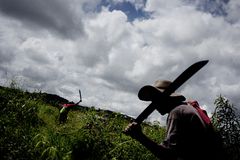As the communities have organised to defend their rights, selective murders of leaders have increased.1 In 2010, nine small-scale farmers who were leading processes to recover seized land were murdered in Urabá.2
Orlando Valencia, an inhabitant of the Curbaradó River Basin, was one of the voices violently silenced when, in 2005, members of paramilitary groups from the “Elmer Cárdenas” Block forced him onto a motorcycle.3 His body was later found with a shot to his head and signs of torture.4
In 2008, alleged paramilitaries murdered Ualberto Hoyos, an inhabitant of the Caño Manso community that had recently returned to the area. Previously, in September 2007, the brothers Miguel and Ualberto Hoyos had survived an attempt against their lives. The Hoyos brothers carried out a fundamental role in the return of 80 displaced families to the Caño Manso community in the Curbaradó River Basin. Miguel Hoyos had also provided testimony in the case of the murder of the farmer Orlando Valencia during hearings carried out in 2006.
In 2009, alleged paramilitaries murdered Benjamín Gómez, an 80-year-old farmer, inhabitant of Caño Manso, and community council member.5
In 2010, alleged paramilitaries murdered Argenito Díaz, who was 42 years old and a member of the board of directors of the Curbaradó River High Council. According to CIJP, “he participated actively in preparing and presenting the writ of protection against the businesspeople in order to recover the collective private property in Llano Rico.”6 Díaz had been threatened in August 2008.7
In March 2012, Manuel Ruiz and his 15-year-old son Samir were disappeared and subsequently killed by alleged paramilitaries8. Manuel Ruiz was one of the community leaders active in the land restitution process in the Curbaradó and Jiguamiandó river basins, one of the processes in President Juan Manuel Santos’ Action Plan (to prioritize and accelerate land restitution processes)9.

